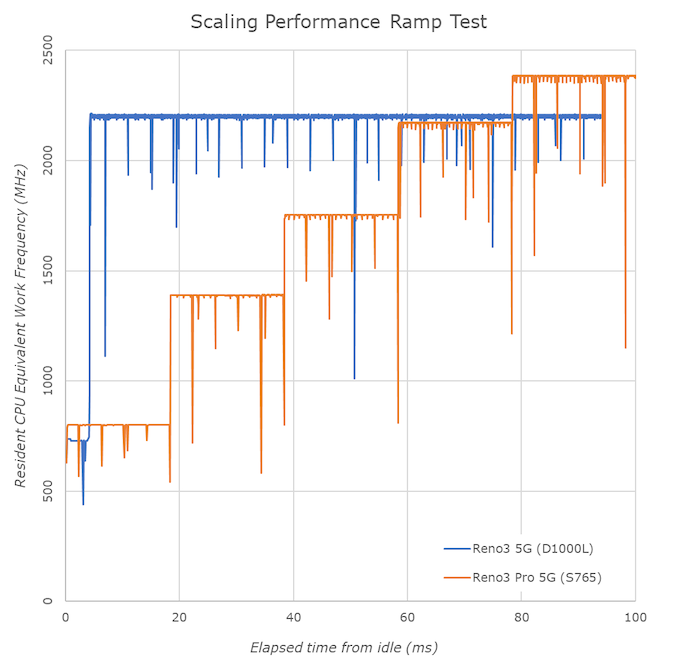OPPO's Reno3 5G vs Reno3 Pro vs Reno3 Pro 5G: Why Don't We See More MediaTek Dimensity 1000 Phones?
by Andrei Frumusanu on August 10, 2020 10:00 AM ESTSystem Performance
Whilst the controlled performance tests are heavily favouring the Dimensity 1000L powered Reno3 5G, what also matters in user experience in daily usage is the overall system performance, including the device’s software stack and the SoC’s scheduler settings. In that regard, we’ve haven’t really tested a MediaTek device in several years now.

In PCMark’s web browsing test, none of the Reno3 phones showcase very convincing results as we’re seeing scores well below the average flagship device today – but that’s to be expected given these phones are targeted at the mid-range.

The writing test is a more representative workload for daily user experiences. Here both the D1000L and S765 Reno3 phones performs in line with their mid-range nature and perform extremely close to each other. The Helio P90 based global Reno3 Pro doesn’t fare well at all here as it’s a clear tier below other phones.

In the photo editing test which makes use of Renderscript and loads the GPU, the MediaTek Reno3 5G is ahead of its P95 sibling as well as the Snapdragon 765 counterpart.

In the data-manipulation score, the Reno3 phones are all performing close to each other.

In the overall PCMark scores, we achieve the expected hierarchy between the devices, although the absolute score differences are quite smaller than we would have imagined.



In the web-browser based JavaScript benchmarks, we’re seeing the Snapdragon 765 notably outperform the Dimensity 1000L chipset which oddly enough falls behind by quite a bit. I’m not too sure of why this would be, but it’s possible that these heavier workloads are more memory-bound and thus Qualcomm’s superior memory latency performance is helping it pull ahead of the MediaTek chipsets.
As we hadn’t measured a MediaTek chipset in quite a few years, I was curious as to how their scheduler performs in relation to what we know of other SoCs such as from Qualcomm, HiSilicon, Samsung or even Apple. We’re using our internal workload performance ramp test for this task:
Surprisingly, MediaTek’s Dimensity 1000L performed massively better than any other SoC on the market, scaling up from idle to maximum frequency on the performance cores in just 4.2ms. The Snapdragon 765 Reno3 Pro 5G here took a more conventional stepped ramp-up approach, reaching the maximum performance state in 78ms.
I was quite astounded to see such an aggressive scheduler behaviour on the MediaTek chipset – it seems their scheduler will wake up tasks at maximum frequency very quickly and ramp down from there, instead of ramping up performance gradually. It’s a big difference, and it’s seemingly a lot more aggressive than any other SoC on the market.
I’m still not sure how this translates into more natural workloads with intermediate load behaviours – both the Reno3 5G and Reno3 Pro 5G both performed quite similarly in subjective device usages, with the MediaTek variant only pulling ahead under more notable workloads such as installing applications.











44 Comments
View All Comments
dotjaz - Wednesday, August 12, 2020 - link
For years they only had interim licensing and they didn't have a license before starting the process, I'd call that stealing.londedoganet - Wednesday, August 12, 2020 - link
> For years they only had interim licensingWhich years? From 2010 to 2014, Apple used stock PowerVR GPUs, and then paid license fees to Imagination from 2014-2017, stopped in 2017 and started again in January 2020 (https://www.theregister.com/2020/01/02/imagination...
deanylev - Monday, August 10, 2020 - link
HiSilicon is spelled as "HiSilcion" on the last page.LiviuTM - Monday, August 10, 2020 - link
I'm no expert by any means, but reviews of mobile SoCs focus only on processing power and efficiency, which lead to one major issue: says absolute nothing about mobile connection quality. I suspect Qualcomm stack (modem/modem firmware, RF Front End, antennas and whatever else there is) is vastly superior.This is not very often talked of (if any at all), but it had a significant impact onreal usage.
Remember Apple not just buried the hatchet with, but also signed a multiyear deal with Qualcomm for chipsets (mainly modems, I presume).
s.yu - Wednesday, August 12, 2020 - link
I believe if you've read enough you'd notice that there's massive discrepancies of connection quality between QC powered models, so at least the front end and antennas should depend primarily on manufacturer implementation.OTOH Huawei diehards claim Huawei has superior connection quality, which I don't dismiss but instead attribute to Huawei's telecoms hardware discriminating against non-Huawei handsets, explaining how these claims only arise from regions where Huawei's telecoms branch comes close to a monopoly, like China, south Asia, the Middle East etc.
shabby - Monday, August 10, 2020 - link
Why is there performance so poor with 4 a77 cores?HyperText - Monday, August 10, 2020 - link
Frequency...dotjaz - Wednesday, August 12, 2020 - link
Nope, if you looked at GB5 and SPEC06, the raw performance is not bad at all, far better than 765G, but the actual performance is lagging behind Reno3 Pro 5G especially with responsiveness/burst load.[ECHO] - Monday, August 10, 2020 - link
Fascinating stuff Andrei, thanks for the write up![ECHO] - Monday, August 10, 2020 - link
It's interesting to see the Dimensity 800/820 actually show up in more phones (couple of Honor and Huawei's, at least one Xiaomi/Redmi) than the 1000/1000L/1000+ so far. Almost makes you wonder if the original wafers they ordered for the 1000's had a pretty bad defect, didn't get caught until far too long after tape out and then they were stuck salvaging some low percentage of good dies for 1000L's and the 1000+ is a pretty deep silicon respin, hopefully with more wafer starts...